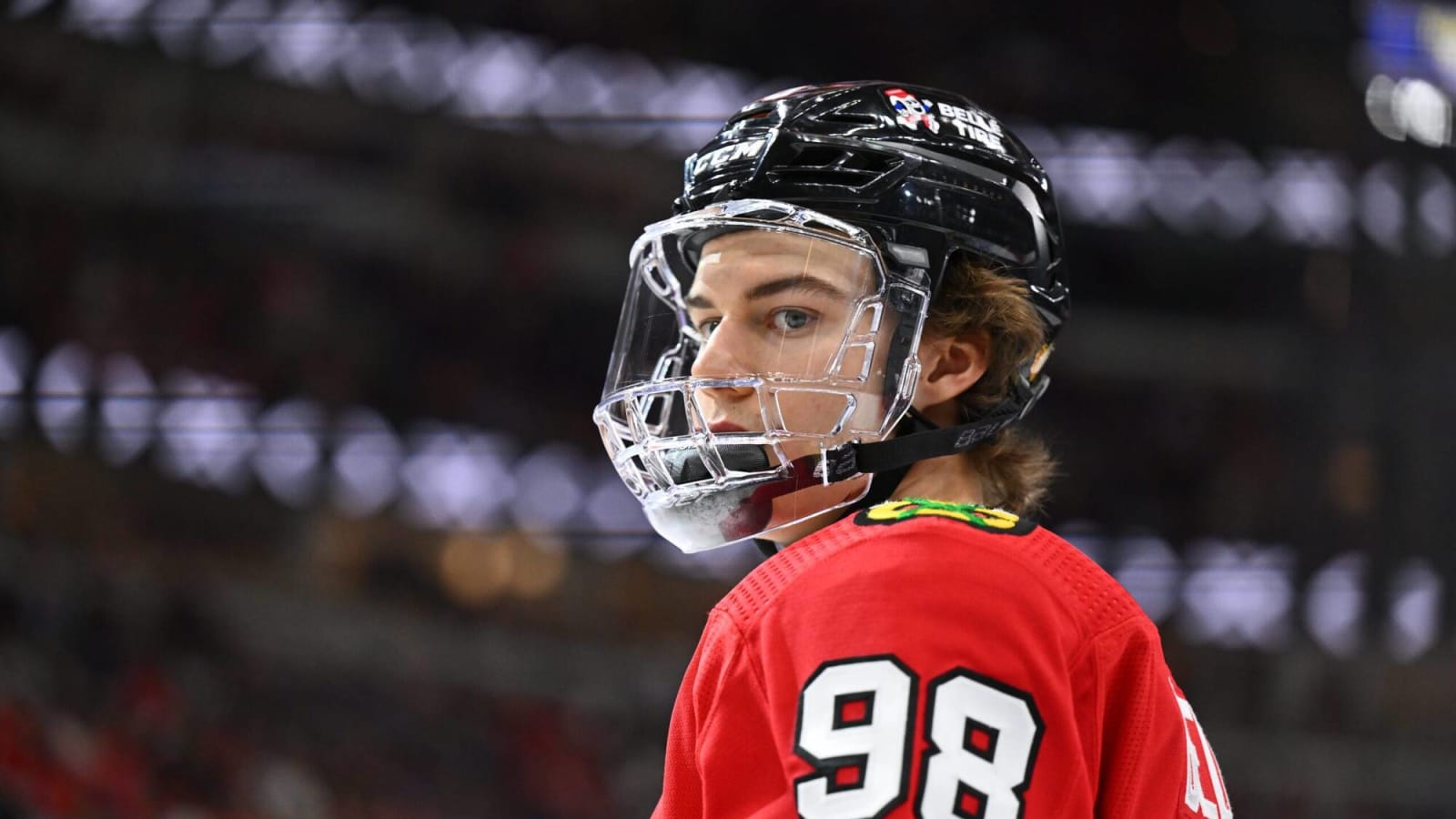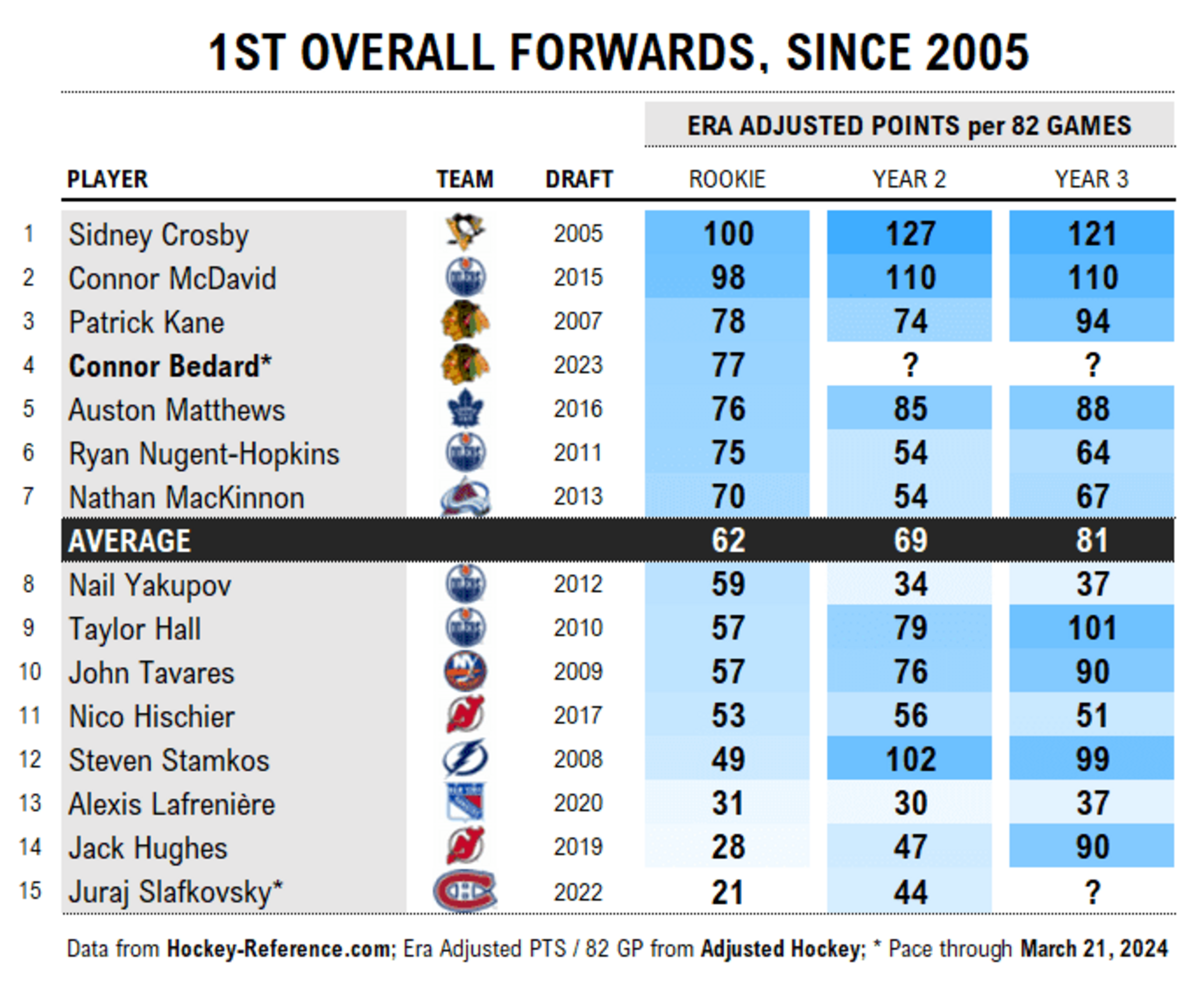
Everyone loves rookie seasons.
The perennial promise of the next generation of talent brings limitless possibilities. While you might lose a step in beer league hockey or see your first gray hair, the next NHL rookie sensations will start fresh every year without fail.
With the latest freshman class featuring the most hyped prospect since Connor McDavid, the push to evaluate, compare and scrutinize goes into overdrive. Spoiler alert: we’re doing that today. But we’re going to take the measured and open-minded view necessary when evaluating an 18-year-old athlete.
With just a dozen games to go in his Chicago Blackhawks’ regular season, we’re diving into Connor Bedard’s rookie year. We’re contrasting his debut to the salary cap era’s first overall picks. And, just for fun, we’re going back in time to check on the early results of generational talents – all the way back to Wayne Gretzky.
Bedard’s 2023-24
Now, it’s no secret the Blackhawks are a few years away from being competitive. If a team wins 19 of its first 70 games, it’s part of a long-term plan – one now built around Bedard. By raw numbers, his stat line is 21 goals, 33 assists, 54 points, and minus-39 in 56 games, averaging 19:36 in ice time per night. Despite missing 14 games to jaw surgery, his point total comfortably leads the Hawks.
But you can read about that anywhere.
How has Bedard looked?
Impressively, he’s been largely as advertised. The jaw-dropping toolkit he showcased in junior hockey has translated smoothly. Bedard’s shot is already world class, his effortless release and ability to make late adjustments with his hands conspiring to regularly fool NHL goalies. While he doesn’t play with the personnel to pad his power play numbers, Bedard’s creativity, vision, and threatening shot have generated significant scoring chances with the man advantage.

JFresh Hockey‘s microstat card above supports the eye test.
Using game tracking by Corey Sznajder’s All Three Zones project, Bedard is already NHL-lethal across most offense-generating metrics. While he’s not a burner in skating speed (61st percentile), the amount of bright blue in the chart above is rare at any age.
Friendly reminder: he’s 18.
Should anyone be concerned about his defense? No, not really. His lackluster defensive impact is not strictly from playing on a lottery team, though. Teammate Jason Dickinson and fellow building block Alex Vlasic provide premium defensive value. While coach Luke Richardson has been pleased with gradual gains in Bedard’s defensive habits, the data shows he’s played the one-way game you might expect from a teenage phenom.
Sure, it would’ve been nice if he arrived as a shot-suppressing center, but let’s be honest, it’s hard to get too excited about his defensive play. Chicago scored only 20 goals in the 14 games Bedard was injured. As the only Ferrari on the lot, the need to push for offense is understandable. By the time the franchise’s competitive window opens, Bedard will be an entirely different player on an overhauled roster.
1st Overall Picks in the Salary Cap Era
We’ll expand our view of Bedard’s rookie year by comparing to recent top draft prospects. Since the 2005 NHL Entry Draft, there have been 15 forwards taken first overall. While high-end draft talent varies, past #1 selections offer some insight on both how Bedard’s season stacks up and how offensive output evolves.

Sidney Crosby remains the gold standard for NHL-ready prodigies, debuting at an era-adjusted 100-point pace. At 19, he joined Gretzky as the only teenage MVP in major pro sports. McDavid was not far behind, winning back-to-back scoring titles in his second and third seasons. Given Bedard’s extreme ambition and comparable pedigree, these two guys offer ideal blueprints.
But even among first overall picks, career destinations can be a mixed bag, ranging from no-doubt Hall of Famers to, well, Nail Yakupov. Both the players and the production above are intriguing.
The clear takeaway is that the road to excellence is not always paved:
- Nugent-Hopkins‘ rookie pace (75) fell off quickly – he wouldn’t top it again until his ninth season.
- MacKinnon‘s rookie pace (70) similarly flatlined – he didn’t break out until his fifth season (110).
- Yakupov‘s peak pace (59) was his debut season – he was out of the NHL by age 24.
- Stamkos was often stapled to the bench as a rookie (49) but doubled his output as a sophomore.
-
Hughes‘ freshman pace (28) brought immediate criticism, yet he was outstanding by Year 3.
Many superstars – Kane, Matthews, Hall, Tavares – saw fairly normal development curves in terms of production. Maybe that’s what we’ll see from Bedard. His first year in Chicago is eerily similar to the franchise pillar he replaced in Kane. Regardless of what’s next, as a rookie on a team starved for scoring, Bedard has already produced near the average rate of a first-overall pick’s third NHL season.
Generational Talents
Now that we’ve had a sensible look at Bedard’s first season, it’s time to say goodbye to our senses. Let’s dream big of what could be – a place among hockey’s titans.
The label ‘generational talent’ is in the eye of the beholder. Is it based on prospect hype? Does the player need to fully realize the talent? Is it both? How far apart is a generation anyway? All great questions, none of which can be objectively answered. But here’s our definition: a player with such unmistakable promise and immediate impact that they reasonably could be the NHL’s best player over a 10-year span.
We’ve got eight forwards spanning 45 years. We’ll start with Gretzky’s debut and work our way to the man of the hour. Let’s not get too hung up on who is (or isn’t) on the list – this is about Bedard after all. We’re reviewing these mega-talents’ career trajectories from age 18 to 24 based on Hockey-Reference‘s January 31st mid-season age cutoff.

So, what can we learn from some of the best to ever do it?
First, due to early birthdays (Gretzky, McDavid), late birthdays delaying draft years (Lemieux, Ovechkin), and refusal to report (Lindros), only two other generational talents have had traditional 18-year-old seasons. Yes, even among teenage studs in NHL history, Bedard is young. In his age-18 season, Bedard is no Crosby. But Jagr at 18 was also no Bedard.
Unlike the cap era’s first overall picks, generational talents become all-world almost immediately, have no meaningful development setbacks, and reach their peak as point producers by 23 or 24.
For Lemieux, his ascension was slightly slower by his lofty standards, hurt by a lack of quality teammates in his early days in Pittsburgh. Jagr, only arriving in North America at 18, marinated a little slower than the others. Crosby and McDavid offer modern templates – hugely hyped, modestly-sized centers and products of Canada’s junior hockey system. Both were era-adjusted 100-point scorers as teens and era-adjusted 140-point scorers by their mid-20s.
Is this a reasonable expectation for Bedard? Perhaps. But lots has to go right to keep up to arguably the two greatest players since Lemieux. Chicago’s fortunes in the draft lottery this spring, as well as the progress of their well-stocked prospect cupboard, will inevitably impact Bedard’s output too. Both factors are out of his hands.
Connor Bedard’s evolution in the months and years ahead will be fascinating. He’s a must-watch talent with the drive to match, and has a blank canvas to paint his story.
And let’s not forget: he’s only 18.
Follow @AdjustedHockey on X; Data from Hockey-Reference.com
More must-reads:
- Maple Leafs star breaks silence on postseason absence, addresses Game 4 status
- Canucks goalie remains sidelined due to injury
- The '100 catches in an NFL season' quiz
Breaking News
Customize Your Newsletter
 +
+
Get the latest news and rumors, customized to your favorite sports and teams. Emailed daily. Always free!

